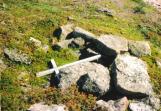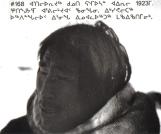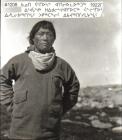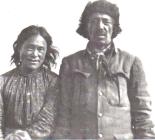1
There were murders committed in the Inuit world between the Inuit, as well as the killing of non-Inuit by Inuit. In many cases, the murderer talks about the fear of being killed, therefore killing somebody else before themselves were killed by that or those persons. In Canadian history there was capital punishment for murder that meant anybody who committed murder was liable to be killed by the justice system. Later on capital punishment was repealed and replaced with, in some cases, life imprisonment. The laws of Canada are continually being changed, revised, and amended.2
The R.C.M.P. records and the Inuit historians will tell the stories themselves. These are few of the examples taken from records and Inuit historian accounts of killings.3
Haqpi, otherwise known as Haqpivini'tuaq's graveAugust 2005
Qikiqtalik, between Beverly Lake and Aberdeen Lake, Nunavut, Canada
 Credits:
Credits:Photographer: Winnie Owingayak
4
The grave of Haqpi, also known as Haqpivini'tuaqHaqpivin'tuaq Killings
Haqpivini'tuaq and his brother Edjougaarjuk and N-ni-ngu-jaaq were working together in the killings. They waited, hiding on the islands and were using them as shields while they watched the target camp throught their telescopes while they waited for nightfall so that they could start shooting the Inuit at the camp. They watched as the two newly weds, who had just gathered heather and moss, were gaily running home, the man leading. Haqpivini'tuaq said, "That one who's going to die tonight, doesn't seem like he's going to die. He's really running fast." So at nightfall when they got to the Inuit camp they went in and they started to eat together, as it is the Inuit custom to eat with new arrivals. The women were eating in a neighboring iglu, as it was the custom to have neighboring igluit. The women were eating next door, in an iglu closet. In this iglu where there were only men eating with Haqpivini'tuaq threesome. Haqpivini'tuaq asked Oolamik's father, "Is it true that you took back my sister-in-law?" When he answered yes, Haqpivini'tuaq went outside and came back. Apparently the rifle was wrapped hidden in a blanket just outside. He suddenly started shooting at the people without warning. He immediate shot and killed two people. The third, Ihagut, quickly ran and hid in the store-room. Somebody said Nipititaaq the woman was outside and Haqpivini'tuaq thinking that she was Anna'lunaaq shot her unintentionally. She was one woman he was going to take with him. Nipititaaq came to the iglu she was going to get to smoke because when Edjougaarjuk went there he was asked what he came for and he said he came for a light to light a cigarette, which was a lie. He was asked what the sound was that sounded like a rifle shot. Edjougaarjuk said, "Maybe caribou cache" meaning somebody killed a caribou and cached (put rocks on top of the caribou until it's covered so that no animals like bears or wolverine can dig it out. The caribou also ferments better without drying out when it is covered with rocks) Annalu'naaq really likes to smoke so when she heard they were smoking next-door she went there and got killed instead. I hagut who was hiding in the store-room saw that his wife Nipititaaq was shot and came out crying whereupon Haqpivini'tuaq immediately shot and killed him. The three dead people were just left at the empty iglu without being buried on the hill right away. There was a young child there at the camp and haqpivini'tuaq threw him in the lake saying that when he grew up he will become a threat.
When they reached Haqpivini'tuaq and Edjougaarjuk's father Haqpivini'tuaq told him that he had exterminated the Akilinirmiut. On hearing this, the father who was in his snow-bed, pawed the snowbed and exclaimed with great remorse, "Oh no, Extreme regreat!" To which Haqpivini'tuaq took a few steps back out of fear of his father. Haqpivini'tuaq came back to this area between Beverly Lake and Aberdeen Lake.
Told by Thomas Qaqimat, Inuit historian and relative of Haqpivini'tuaq. Thomas Qaqimat is originally lived in the Killinirmiut and Harvaqtuurmiut area. He is originally a Killinirmiutaq, but now lives in Baker Lake, Nunavut, Canada.
5
An Inuk wearing caribou coat1923
Pelly Bay, Nunavut, Canada
 Credits:
Credits:Rasmussen, Knud
Photo #0168. The Fifth Thule Expedition
National Museum of Denmark
6
Knud Rasmussen of The Fifth Thule Expedition writes about this murderer Iksivalitaaq from Aivilik. His father was Opirngaalik. The book is introduced by Terrence Cole.There are accounts of various Inuit from the Arctic who committed murder. Inuit elders tell about what they heard from stories of how it happened and the events are very similar to RCMP records.
7
Igjugaarjuk, Inuk from Yathkyed Lake1922
Hikuliqjuaq, Yathkyed Lake, Nunavut, Canada
 Credits:
Credits:Rasmussen, Knud
Photo #1208. The Fifth Thule Expedition
National Museum of Denmark
8
RCMP Annual Report year ended September 30, 1920ROYAL CANADIAN MOUNTED POLICE COMMISSIONER'S REPORT
11 GEORGE V, A. 1921 SESSIONAL PAPER No. 28
ALLEGED MURDERS NEAR BAKER LAKE
"In the winter of 1919-20, Sergeant W.O. Douglas was in charge of the detachment at Fullerton. This detachment, over 400 miles farther north than Churchill, and 100 miles up the coast from Chesterfield Inlet, at this period was the centre of very active patrolling; from September 1916 to January 1919, the distance covered by patrols based on it was nearly 16,000 miles.
On December 19, 1919, Sergeant Douglas, with Constable Eyre and two natives left Fullerton for Chesterfield Inlet, arriving on December 22, after being delayed for a day by a blizzard. At the Hudson's Bay Company's post a letter was waiting for him from the manager of the Hudson's Bay Company's post at Baker Lake, 150 miles inland up Chesterfield Inlet, informing him that two of this hunters had been murdered by another native, that the murderer was at large, and that the native population of the region was badly frightened. Sergeant Douglas at once decided to go up the Inlet to Baker Lake. The necessary arrangements took time as it was necessary to get additional dog-feed, etc. From Fullerton; and on January 1, 1920, Sergeant Douglas, after sending Constable Eyre back to Fullerton, set out for Baker Lake; he had with him two natives and two dog t4eams. He arrived at Baker Lake on January 8.
The information obtainable was meager. An Eskimo of the Padlemiut tribe named ou-wang-wak, living about 150 miles south, was reported to have shot dead two brothers, also of the same tribe, named Ang-alook-you-ak and Ale-cummmick, and had appropriated the wife of the former. The other Eskimo were so afraid of Ou-ang-wak that they were keeping away from the Baker Lake post. Sergeant Douglas resolved to patrol to the scene of the murder, to investigate, and if necessary to arrest the accused. At once difficulties arose which delayed him for nearly three weeks, for the natives were afraid to accompany him. He reports:-
"I experienced great difficulty in getting anyone to make the trip. At last I managed to get a native who assured me he knew the country, but refused to pull out with less than three sleds and four or five men. He said that he had heard that this native had said that he would never be taken alive by the Police. This he gave as a reason for wanting such a large outfit.
After much trouble, Sergeant Douglas got together a party of four Eskimo men and the wife of one of them, together with three dog trains, and left Baker Lake on January 27. An illustration of the difficulties of travel in these regions is afforded by the party's pre-occupation with dog-feed; none of this was carried on the journey and the animals on which their transport depended lived for the first four or five days on deer (caribou) which were shot as the party went along, and for the rest of the time on an insufficient amount of "summer cache meat' which Sergeant Douglas managed to buy.
On February 5, they arrived at a native camp of two igloos, and found two lads of a tribe whose name is variously spelled as Shav-voe-toe and Shag-wak-toe. Sergeant Douglas's natives were so afraid of Ou-ang-wak-they thought he might be there-that he had difficulty in inducing them to drive up to the igloos and see who the inhabitants were. 'It caused much laughter amongst themselves when they found that one of the men was a guide's own brother-in-law.' The news was that the object of the search was encamped about two days farther on, and he had been warned by some white men that the Police would be after him and would kill him (due to capital punishment) and that he was in a state of extreme nervousness. 'When last seen by these lads, he was sitting in his igloo with his hand over his face, and every few minutes getting up and getting out to see if there were any strange sleds about.'
All this increased the dread of Sergeant Douglas's natives, and they resolved to go home. He found that there was a native camp midway between the place where they were and Ou-ang-wak's camp, and he, in the end, persuaded his escort to proceed to this half-way house. The arrived there on the afternoon of February 7.
'On our arrival at this camp we were met some distance from the igloos by a young lad who wished to find out all about us and report to the chief. After some delay he returned and told us that Edjogajuch, the chief of the tribe, wished to see us in his igloo. Negvic, the guide, Native Joe and myself returned with this man, the other two members of the party staying with sleds. After entering the igloo, I shook hands all around, took off my koolotang (caribou coat for outside), sat up on the bench beside the chief and told him that we were hungry and would like to eat with him. He produced a frozen deer and several small butcher knives. We all sat around and ate. This put things on a better footing and all the natives started to talk, and our other two men came in. After we finished eating, I produced tobacco and matches and when everybody had got their pipes going, with Native Joe as an interpreter. I told them what I had come for.
'Edjogajuch replied saying he was sorry that I had come, and telling me that Ou-wang-wak was living one day's travel from his camp. He also warned me not to go there as he had just left this camp and was afraid that if a white man went there and tried to bring away Ou-ang-wak there would be shooting.
'This put the finishing touch to my natives and they refused point blank to go ahead another step.'
Negotiations ensued.
'I had an igloo built and sent for Edjogajuch. I then told him through the interpreter that I had heard that one of his tribe, Ou-ang-wak, had killed two men. He replied that this was so. I further told him that this was contrary to white man's law, and that I was down here to see that Ou-ang-wak and that I was not leaving without doing so. I then suggested that in the morning he take me to the camp across the lake. This he refused to do, as he said that he also might get shot.
'I tried again to get my natives to go with me to this camp, but without success. I sent again for Edjogajuch and told him that I looked upon him as a chief in this district, and it was up to him to either to take me to this camp or go there himself and bring this native Ou-ang-wak to me. He said that he would not go with me but would go alone and try and get him. I told him that I would wait here at this camp for three days and if at the end of that time he was not back, or had no word for him, I should come myself to look for Ou-ang-wak. He was much afraid as he undoubtedly believed that as soon as I saw Ou-ang-wak I should shoot him. I gave him my word that no harm would come Ou-ang-wak or any of the natives if they did what was right and showed no strife.
Accordingly, on February 8, Edjogajuch left his camp, and late in the afternoon of February 9 he returned with Ou-an-wak and the woman." (Pages 11-12).
On their arrival at the camp Sergeant Douglas arrested Ou-ang-wak and, 'I then told him that he would have to come with me to the white man's land as the Big Chief there wanted to see him. He asked me what they were going to do with him and would they kill him. I told him that I had no idea, but I assured him that if he acted square with me he would be looked after well and taken outside to the Big White Chief...'
Sergeant Douglas took Ou-ang-wak and the woman to Baker Lake, Chesterfield Inlet, and Churchill Manitoba. He then took Ou-ang-wak to Fort Nelson, The Pas, and then to Dauphin, Manitoba.
9
Padlirmiut couple standing1922
Arviat, Nunavut, Canada
 Credits:
Credits:The Fifth Thule Expedition
National Museum of Denmark
10
REPORT OF THE BATHURST INLET PATROL, ROYAL NORTHWEST MOUNTED POLICE. 1917-18.Next spring, reports reached civilization that they had been murdered by the Eskimos on 5th June, 1912. Under date of 31st May 1913, Sergeant W.G. Edgenton, who was in command of the post at Fullerton, reported the occurrence, the particulars as he received them roving to be substantially accurate. A few days later one of the Eskimos who had travelled with the ill-fated men from Schultz Lake came to Chesterfield Inlet, and gave a statement to (Mr. Ford) to his immediate superior in the following letter, under date of 11th June, 1913:
"The Eskimo Akulack, who took the Radford party from Schultz Lake to Bathurst Inlet, arrived to-day and reported that both Mr. Radford and Mr. Street were murdered by the Bathurst Inlet Eskimos. Cow-muck, Mr. Ford's trader at Schultz Lake, was the first to bring down the news, but as I ... I placed very little confidence in it until I saw Akulack myself.
"Both Mr. Ford, and myself questioned him twice to-day, and his version of the story was practically the same as Cow-muck's.
"Akulack left Mr. Radford about the 5th of June, and spent the summer a little south of the Eskimos, but came in contact with them several times, and also bought a wife from them some time after the murder, whom he bought with a rifle..." (Introduction)
ROYAL NORTHWEST MOUNTED POLICE REPORT OF SERGEANT-MAJOR CULKIN
SERGEANT-MAJOR T.B. CAULKIN-BAKER LAKE TO CHESTERFIELD INLET AND FULLERTON, AND RETURN.
Baker Lake Detachment,
March 27, 1916.
The Officer Commanding,
R.N.W.M. Police,
Baker Lake Sub-district.
SIR,-I have the honour to submit herewith report of the patrol to the mouth of Chesterfield Inlet, and north to Cape Fullerton, made by Constable Kennedy, A.B., native "Akular," and myself, with dog-team (10 dogs), leaving Baker lake detachment on Thursday, February 10, in accordance with your instructions.
The objects of the patrol being to connect with the Nelson and Churchill, patrol, and exchange mails, also to patrol to Fullerton with a view to collecting the duty on the goods shipped to G.G. Cleveland, trader, per the schooner A.T. Gifford, arriving from the U.S. last fall...
"ELLIS ISLAND TO FULLERTON
At about mid-day on September 2 (1916) Corporal Joyce, Constables Convway and Walker, with some Fullerton natives as crew, left Ellis island in the whaleboat bound for Fullerton. This was in accordance with instructions received from Churchill. A few moments after we raised anchor and left Ellis Island bound for Churchill. On board McTavish were Sergeant MacArthur, Corporal Reeves, Constables McMillan and McDiarmid, Special Constable Ford, natives Pook, Tuperlock, Bye & Bye and his wife and myself (Inspector Pelletier)..." (P. 161)
The McTavish lost its anchor and was badly shattered in the bow. On September the 10th (1916) he crew were forced to go to Cape Fullerton on a police whaleboat.
REPORT OF THE BATHURST INLET PATROL, ROYAL NORTHWEST MOUNTED POLICE. 1917-18.
In 1911 two white men, Mr. H.V. Radford and Mr. T. G. Street, undertook a journey in the Far North. Mr. Radford was an American who had done some exploring in the northern areas, and had made collections for the United States Biological Society of Washington; Mr. Street, who was a younger man, was a Canadian, a native of Ottawa. They wintered near Schultz Lake, and early in 1912 reached Bathurst inlet, intending to proceed westward along the Arctic coast to Fort McPerson; at Bathurst inlet they found an encampment of Eskimos of a tribe which had had little interaction with white men. The Eskimos who had brought them on their way from Schultz Lake turned back; the travellers had arranged to procure assistance in travelling from the Eskimos among whom they now found themselves. This was in the first days of June, 1912.
Next spring reports reached civilization that they had been murdered by the Eskimos on 5th June, 1912. Under date of 31st May, 1913, Sergeant W.G. Edgenton, who was in command of the post at Fullerton, reported the occurrence, the particulars as he received them roving to be substantially accurate. A few days later one of the Eskimos who had travelled with the ill-fated men from Schultz lake came to Chesterfield inlet, and gave a statement to (Mr. Ford) to his immediate superior in the following letter, under date of 11th June, 1913:-
"The Eskimo Akulack, who took the Radford party from Schultz Lake to Bathurst Inlet, arrived to-day and reported that both Mr. Radford and Mr. Street were murdered by the Bathurst Inlet Eskimos. Cow-muck, Mr. Ford's trader at Schultz lake, was the first to bring down the news, but as I ... I placed very little confidence in it until I saw Akulack myself.
"Both Mr. Ford, and myself questioned him twice to-day, and his version of the story was practically the same as Cow-muck's.
"Akulack left Mr. Radford about the 5th of June, and spent the summer a little south of the Eskimos, but came in contact with them several times, and also bought a wife from them some time after the murder, whom he bought with a rifle..." (Introduction)
ROYAL NORTHWEST MOUNTED POLICE
REPORT OF SERGEANT-MAJOR CULKIN
SERGEANT-MAJOR T.B. CAULKIN-BAKER LAKE TO CHESTERFIELD INLET AND FULLERTON, AND RETURN.
Baker Lake Detachment,
March 27, 1916.
The Officer Commanding,
R.N.W.M. Police,
Baker Lake Sub-district.
SIR,-I have the honour to submit herewith report of the patrol to the mouth of Chesterfield Inlet, and north to Cape Fullerton, made by Constable Kennedy, A.B., native "Akular," and myself, with dog-team (10 dogs), leaving Baker Lake detachment on Thursday, February 10, in accordance with your instructions.
The objects of the patrol being to connect with the Nelson and Churchill, patrol, and exchange mails, also to patrol to Fullerton with a view to collecting the duty on the goods shipped to G.G. Cleveland, trader, per the schooner A.T. Gifford, arriving from the U.S. last fall...